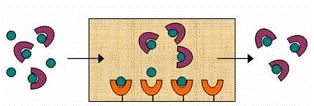Department of Chemistry
Document Type
Article
Date of this Version
11-2012
Citation
Published in final edited form as: J Chromatogr A. 2012 November 23; 1265: 114–122. doi:10.1016/j.chroma.2012.09.091. Version presented here is from NIH PubMed Central.
Abstract
High-performance affinity chromatography (HPAC) was used to examine the changes in binding that occur for the sulfonylurea drug glibenclamide with human serum albumin (HSA) at various stages of glycation for HSA. Frontal analysis on columns containing normal HSA or glycated HSA indicated glibenclamide was interacting through both high affinity sites (association equilibrium constant, Ka, 1.4–1.9 × 106 M−1 at pH 7.4 and 37°C) and lower affinity sites (Ka, 4.4– 7.2 × 104 M−1). Competition studies were used to examine the effect of glycation at specific binding sites of HSA. An increase in affinity of 1.7- to 1.9-fold was seen at Sudlow site I with moderate to high levels of glycation. An even larger increase of 4.3- to 6.0-fold in affinity was noted at Sudlow site II for all of the tested samples of glycated HSA. A slight decrease in affinity may have occurred at the digitoxin site, but this change was not significant for any individual glycated HSA sample. These results illustrate how HPAC can be used as tool for examining the interactions of relatively non-polar drugs like glibenclamide with modified proteins and should lead to a more complete understanding of how glycation can alter the binding of drugs in blood.



Comments
Copyright Elsevier Inc. Used by permission